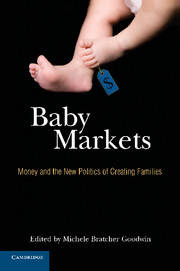Book contents
- Frontmatter
- Contents
- Preface
- Acknowledgments
- Introduction
- PART ONE WHAT MAKES A MARKET? EFFICIENCY, ACCOUNTABILITY, AND RELIABILITY OR GETTING THE BABIES WE WANT
- PART TWO SPACE AND PLACE: REPRODUCING AND REFRAMING SOCIAL NORMS OF RACE, CLASS, GENDER, AND OTHERNESS
- 6 Adoption Laws and Practices: Serving Whose Interests?
- 7 International Adoption: The Human Rights Issues
- 8 Heterosexuality as a Prenatal Social Problem: Why Parents and Courts Have a Taste for Heterosexuality
- 9 Transracial Adoption of Black Children: An Economic Analysis
- PART THREE SPECTRUMS AND DISCOURSES: RIGHTS, REGULATIONS, AND CHOICE
- PART FOUR THE ETHICS OF BABY AND EMBRYO MARKETS
- PART FIVE TENUOUS GROUNDS AND BABY TABOOS
- Author Bios
- Index
- References
8 - Heterosexuality as a Prenatal Social Problem: Why Parents and Courts Have a Taste for Heterosexuality
Published online by Cambridge University Press: 05 August 2012
- Frontmatter
- Contents
- Preface
- Acknowledgments
- Introduction
- PART ONE WHAT MAKES A MARKET? EFFICIENCY, ACCOUNTABILITY, AND RELIABILITY OR GETTING THE BABIES WE WANT
- PART TWO SPACE AND PLACE: REPRODUCING AND REFRAMING SOCIAL NORMS OF RACE, CLASS, GENDER, AND OTHERNESS
- 6 Adoption Laws and Practices: Serving Whose Interests?
- 7 International Adoption: The Human Rights Issues
- 8 Heterosexuality as a Prenatal Social Problem: Why Parents and Courts Have a Taste for Heterosexuality
- 9 Transracial Adoption of Black Children: An Economic Analysis
- PART THREE SPECTRUMS AND DISCOURSES: RIGHTS, REGULATIONS, AND CHOICE
- PART FOUR THE ETHICS OF BABY AND EMBRYO MARKETS
- PART FIVE TENUOUS GROUNDS AND BABY TABOOS
- Author Bios
- Index
- References
Summary
José: Hey, Dick, would you rather have a whole gay baby or a straight one without a little toe?
Dick: Yuck, what a weird question. I don't know. I never really gave it much thought.
Jane: Well … I think that I'd rather have the straight baby. People don't really see your toes … and who needs two little toes, anyway?
José: Indeed. How about a whole gay baby or a straight one without a pinkie?
Jane: Gee, that's harder. I mean, you can see a missing pinkie.
Dick: Ughghg …
José: So true. Well, then, how about a whole gay baby or a straight one without a thumb?
Jane: A thumb! An opposable thumb? No way, José. Now you've gone too far. You can't do anything without a thumb … I'll take the gay baby.
Dick: Oh, jeez …
Michele Bratcher Goodwin has analyzed the race discount in adoption markets and recommended reforms to mitigate marketized racism in this secondary market for children. Analogizing to her argument, I argue that many – perhaps most – heterosexual would-be parents also have a strong preference for heterosexuality in offspring: what I call the “taste” for heterosexuality. It may seem harmless and even benevolent, given the animus to which sexual minorities are subject at the hands of judges, legislators, deans, teachers, doctors, and even their families. But the taste contributes to the very condition – risk to sexual minorities – which would-be parents often use to justify a heterosexuality offspring preference: “It's for the child's sake, not my own.”
- Type
- Chapter
- Information
- Baby MarketsMoney and the New Politics of Creating Families, pp. 118 - 131Publisher: Cambridge University PressPrint publication year: 2010



